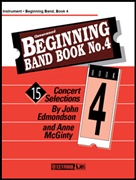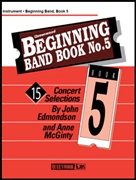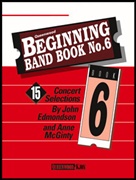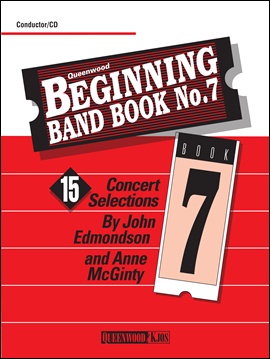Results
-
 £22.50
£22.50BEGINNING BAND BOOK No.4 (Score inc. CD) - Edmondson & McGinty
An affordable collection of concert repertoire for beginning bands; great sight reading material for more advanced bands! Features include: Grade 1 concert band music; Playable with only 1 flute, 2 clarinets, 1 alto saxophone, 2 cornets/trumpets and percussion, up to full instrumentation; Full, complete sound, even without bass clef instruments. The bass clef part in octaves is optional; Both clarinet parts stay below the break; Optional F Horn and Tenor Saxophone parts are written in their best ranges; Bell part for teaching melodic percussion. Contents: Air and Caprice; American Folk Trilogy; Anthem and March; Celebration for Winds; Chatterbox; Concerto for Sleigh Bells and Band; Instant Christmas Concert; Knock on Wood; Liberty March; Madrigal for Band; March for a Festival; The Mohawk Trail; Overture in F; Those Intrepid Trumpets; Variations on a Children's Song.
Estimated dispatch 7-14 working days
-
 £22.50
£22.50BEGINNING BAND BOOK No.5 (Score inc. CD) - Edmondson & McGinty
An affordable collection of concert repertoire for beginning bands; great sight reading material for more advanced bands! Features include: Grade 1 concert band music; Playable with only 1 flute, 2 clarinets, 1 alto saxophone, 2 cornets/trumpets and percussion, up to full instrumentation; Full, complete sound, even without bass clef instruments. The bass clef part in octaves is optional; Both clarinet parts stay below the break; Optional F Horn and Tenor Saxophone parts are written in their best ranges; Bell part for teaching melodic percussion. Contents: Canterbury Overture; Chant and Gloria; Clouds; The Debonair Dragon; Flute Loops; Folk Song Folks; Little Rhondo for Band; Mariachi Serenade; Mount Rushmore March; Omega March; Oxford Overture; A Regal Procession; Serenade and Dance; Serpents; Those Dynamic Drummers.
Estimated dispatch 7-14 working days
-
 £22.50
£22.50BEGINNING BAND BOOK No.6 (Score inc. CD) - Edmondson & McGinty
An affordable collection of concert repertoire for beginning bands; great sight reading material for more advanced bands! Features include: Grade 1 concert band music; Playable with only 1 flute, 2 clarinets, 1 alto saxophone, 2 cornets/trumpets and percussion, up to full instrumentation; Full, complete sound, even without bass clef instruments. The bass clef part in octaves is optional; Both clarinet parts stay below the break; Optional F Horn and Tenor Saxophone parts are written in their best ranges; Bell part for teaching melodic percussion. Contents: Bells, Bells, Bells; Command Z; Fire Dance; The Funky Turtle; In the Zone; Introduction and Scherzo; Japanese Folk Trilogy; Kum Ba Yah; Morningstar Overture; Mount Vernon March; Multiple Choice; Ramsgate Festival; Stratford Fair; Superstition Overture; Those Clever Clarinets.
Estimated dispatch 7-14 working days
-
 £22.50
£22.50BEGINNING BAND BOOK No.7 (Score inc. CD) - Edmondson & McGinty
An affordable collection of concert repertoire for beginning bands; great sight reading material for more advanced bands! Features include: Grade 1 concert band music; Playable with only 1 flute, 2 clarinets, 1 alto saxophone, 2 cornets/trumpets and percussion, up to full instrumentation; Full, complete sound, even without bass clef instruments. The bass clef part in octaves is optional; Both clarinet parts stay below the break; Optional F Horn and Tenor Saxophone parts are written in their best ranges; Bell part for teaching melodic percussion. Contents: African Folk Trilogy; African Folk Trilogy #2; Chippewa Lullaby; The Golden Eagle March; Hymn and Hosanna; Join the Crowd; Kings, Kings, Kings; The Lost City; March of Freedom; Mystery of the Maya; Name Those Carols; Quicksilver Overture; Take Me Out to the Ball Game; Wellington Overture; Wolseys Wilde.
Estimated dispatch 7-14 working days
-
 £75.52
£75.52Temperamental (Concert Band) Fendall Hill
This work by Fendall Hill was the set test for the 2021 National Brass Band Championships of New Zealand, B Grade. Here it has been adapted for Concert Band. The composer writes: 'J.S. Bach (1685-1750) is deemed by many to be the 'Ulimate Composer'. He added an incredible proportion to the DNA of western music, and his influence is heard in the music of today. Like many artists, he was not overly recognised as a composer during his lifetime, and it took an 1829 performance of the St Matthew Passion by Mendelssohn to ignite a recognition of his place in the music world, a place he has maintained ever since. This piece starts with a similar spark of rediscovery of the music of Bach. It contains arrangements of various works, interspersed with composition based on Bach's chord structures, sections in the style of Bach, and original sections inspired by the moods created along the way. The first section explores the Toccata, and great organ works. This leads into an exploration of his choral works, and a finale based on the Preludes. The word 'Tempered' has different meanings, and all seem to apply to the music of Bach, and these appeal to the musical, engineering and spiritual aspects of my personal life. His music reaches to the humanity and divinity, it has strength, structure and order that creates frameworks in which incredible complexity reigns; and the complexity leads to a wildness, a kind of craziness that represents a range of human moods, and can change without warning. The same piece of music affects people in very different ways. I don't know if it's Bach's music, or us, but it can seem out of control and under control at the same time - the combination is highly temperamental. To view a follow-the-score video of the work please visit: https://youtu.be/6CtYZmCoWIc Sheet music available from: UK: www.wind-band-music.co.uk USA: www.solidbrassmusic.com Difficulty Level: Advanced Instrumentation: Instrumentation: Piccolo Flute 1-2 Oboe Bassoon Clarinet in Bb 1-3 Bass Clarinet in Bb Alto Saxophone 1-2 Tenor Saxophone Baritone Saxophone Trumpet in Bb 1-3 Horn in F 1-4 Trombone 1-2 Bass Trombone Euphonium Tuba Double Bass Timpani Percussion 1-3
In stock: Estimated dispatch 1-3 days
-
Fenix Blue - Peter Meechan
Fenix Blue is a solo work for alto saxophone and wind ensemble, commissioned by and written for British saxophonist, Tim Watson.A wild blues inspired opening for unaccompanied saxophone gives way for a slow, dirty blues! More blues elements appear in the following slow funk section, driven by the percussion section and drum kit.Slow reflective music follows before a return to the slow funk - this time with plenty of the original blues music interjected around the band and from the soloist, leading to a loud conclusion!The title makes reference to the large blues influence in the piece, but the Fenix referred to in the title is a dedication to the Phoenix 2 capsule that rescued the 33 Chilean minors who were trapped underground for 69 days last year, the last of whom was brought to the surface in the capsule as I was finishing this piece.
Estimated dispatch 5-14 working days
-
 £37.76
£37.76Courte Ouverture (Wind Band) Tom Juzwiak
'Courte Ouverture' as translated from the French means 'Short Overture'. Written for a medium level ensemble, it commences with a high trill in the piccolo followed by a flourish in the flutes before the main theme is introduced. This primary melody can be heard throughout the selection. It then transitions into an almost hymn-like middle section before an accelerando takes us back to the flute flourish and main theme. This piece uses the music ensemble to its fullest. Memorable melodies and traditional harmonies are spread throughout the instrumentation. To view a rolling score video of the work please visit https://www.youtube.com/watch?v=Qh3e4-XDDxM Sheet music available from www.wind-band-music.co.uk Difficulty Level: Medium Instrumentation: Piccolo Flute Oboe Bassoon Clarinet in Bb 1-3 Bass Clarinet in Bb Alto Saxophone 1-2 Tenor Saxophone Trumpet in Bb 1-3 Horn in F 1-2 Trombone 1-3 Euphonium Baritone Horn Tuba Timpani Snare Drum Bass Drum Cymbals Chimes Glockenspiel Xylophone
In stock: Estimated dispatch 1-3 days
-
 £44.95
£44.95Two Susato Dances (Concert Band - Score and Parts) - Susato, Tielman - Ellerby, Martin
Around 1540 Tielman Susato, the Belgium trumpet player and composer, established himself in Antwerp as a printer of music. In 1551 he brought out The Third Little Music Book, a collection of instrumental dances. Most of these are arrangements, possible by Susato himself, of popular dance tunes. In keeping with sixteenth-century practice, this book details no specific instrumentation; something to be worked out by the players with whatever available means. Doubtless many of the dances were performed on wind instruments at festive outdoor events. The date of Susato's birth is unknown but estimated to be around 1500. The same applied to his death, which is thought to be somewhere between 1561-64.The third Little Music Book gives several examples of the traditional sixteenth-century genre, the dance pair, a predecessor of the Baroque suite. In such a pair the first dance was often in slow or moderate duple time, the second in quick triple time. This is the case in the pair presented here, which consists of a lively round dance followed by a Hop Up or saltarello.Titles in the Prelude Series are specifically scored for bands with few, if any, bass instruments but will sound well on larger ensembles. The bass line is playable by any combination of bass clarinet, bassoon, baritone saxophone, trombone, euphonium or tuba; in the event that none of these is available, the part for trombone/euphonium (B flat TC) can be played by tenor saxophone. The tuned percussion part is entirely optional and can be played by any available instrument(s). Each piece also includes a preliminary exercise. This is always in the same key as the accompanying piece and consists of a scale and chord progression that can be used for improving ensemble, balance, intonation and instrumental facility by changing tempo, articulation and dynamics.Duration: 2.00
Estimated dispatch 7-14 working days
-
£184.99
Rubicon - Bert Appermont
The Rubicon is a river in Northern Italy which Julius Caesar crossed with his army in 49 BC in defiance of the leaders of Rome, who feared his power. A civil war against rival Pompey ensued, which culminated in Caesar seizing power as the absoluteruler of Rome. The phrase "crossing the Rubicon" therefore refers to any person committing himself irrevocably to a risky, decisive and irrevocable of course of action.The work consists of three parts that deal with this important moment in history.Part 1 (Meditation) symbolises Caesars request to the Gods to assist him in his difficult choice. In a slow introduction we hear the melancholy and beseeching sounds of the duduk (alternatively, this part can be played by a soprano saxophone)and of the soprano solo singer over the bourdon accompaniment. The soprano solo singer then sings "dona tibi pacem" (give him rest) in a melodious and probing theme.In Part 2 (Battle of Pharsalus) trumpets and trombones resound alternately ina stately Roman fanfare, producing a stereophonic effect. This develops into a martial theme in which Caesars impressive army goes to battle against the army of rival Pompey. While the theme of Caesars army fades away, Pompeys theme emerges as anaive dance in six-eight time. His army is definitely in the majority and it believes it can easily defeat the enemy. Suddenly trumpets and trombones clash on two sides of the orchestra: Caesars army advances and attacks. A fierce battle ensues inwhich the two themes are played alternately as well as simultaneously. Thanks to his shrewd battle tactics, Caesar manages to win this legendary battle after all: his theme resounds ever louder in trumpets and horns until everything dies out andchanges into a kind of reconciliation between the soldiers of the two armies. The melancholy "dona tibi pacem" from part 1 now serves as a reconciliation theme.Caesar is now the sole ruler of the New Roman Empire, which would be destined to leave itsmark on our Western civilisation to this day. The third part is a sparkling succession of dance music (Dance) with many Greek and Roman elements in which Caesars victory is praised and celebrated. It is common knowledge that the culture(arts, gods, etc.) of the Romans drew heavily on Greek culture. I have therefore used an authentic Greek theme (the Seikolos song) several times in this part (bar 17 in the euphonium, bar 60 in the base section, bar 68 in the sopranosaxophone) to suggest the music of that era and to evoke the right atmosphere. After a gradual increase in tempo in the entire orchestra, the opening melody gloriously resounds once more, surrounded by virtuoso dance music. The work ends withbombastic brass fanfares in which Caesars theme triumphs once more.NOTE FOR THE CONDUCTOR:The Armenian duduk and the monochord that are used in the introduction give a special tone to the music, but could be substituted (soprano saxophone instead ofthe duduk) or left out (monochord). The soprano solo is also doubled within the orchestra and could therefore also be left out if necessary, although it does provide the work with an extra dimension. The male voices in the introduction and the finalecould possibly be replaced with a synthesizer with choral setting.As a visual and acoustic element in part 2, the trumpets, the e-flat cornet, the small drum and trombones can be stood up and placed at two sides of the orchestra (bar 80).Seen fromthe point of view of the conductor, put the trumpets, the e-flat cornet and the small drum in the left section and the trombones in the right section of the orchestra. This also helps to create a visual contrast between the two themes of the secondpart. The players can be seated again at bar 97 or bar 121. The soprano soloist can be placed in or in front of the orchestra, depending on what gives the best result. For the conclusion of the work the soprano solo can be sung from afar (from thewings) to create additional atmosphere.This work was composed especially for the "St Joseph" brass band from Pey/Echt (Belgium) with conductor Mark Prils.
Estimated dispatch 7-14 working days
-
 £148.99
£148.99Rising into a new era - Hermann Pallhuber
"Rising into a New Era" was commissioned by the city of Landeck in 2023 to commemorate its 100th anniversary since being declared a city. The composition serves as the introductory part of a trilogy, encapsulating the years from 1923 to 1956, depicting Landeck's transformation from a market town to a city. The outset of the piece is characterized by a reserved and hushed atmosphere, reflecting the initial uncertainty during a period of economic challenges. The optimistic anticipation of a new beginning is only echoed by the sound of the city's new bells. The central motif, threading throughout the entire composition, is derived from the name of the city: LAnDECk (A-D-E-C). This motif unfolds at the onset within the resonance of the city's bells, gradually evolving into the main theme through the gentle tones of the clarinets. Following the initial years of the burgeoning city, where a positive societal shift and newfound security are symbolized by a second musical theme, the sudden eruption of the Second World War disrupts this progress. A mournful melody, borrowed from the cheerful second theme of the piece, speaks of sorrow, nostalgia, yet also solace and hope for peace and freedom. A "Vivace furioso" captures the uncertainties and intense turbulence of the war. These tumultuous emotions gradually settle, culminating after a delicate oboe and saxophone solo into the now powerful main theme presented in the form of a majestic chorale. A "Vivace con bravura" brings the composition to a radiant conclusion, signifying a strengthened future for the city of Landeck.
Estimated dispatch 7-14 working days
